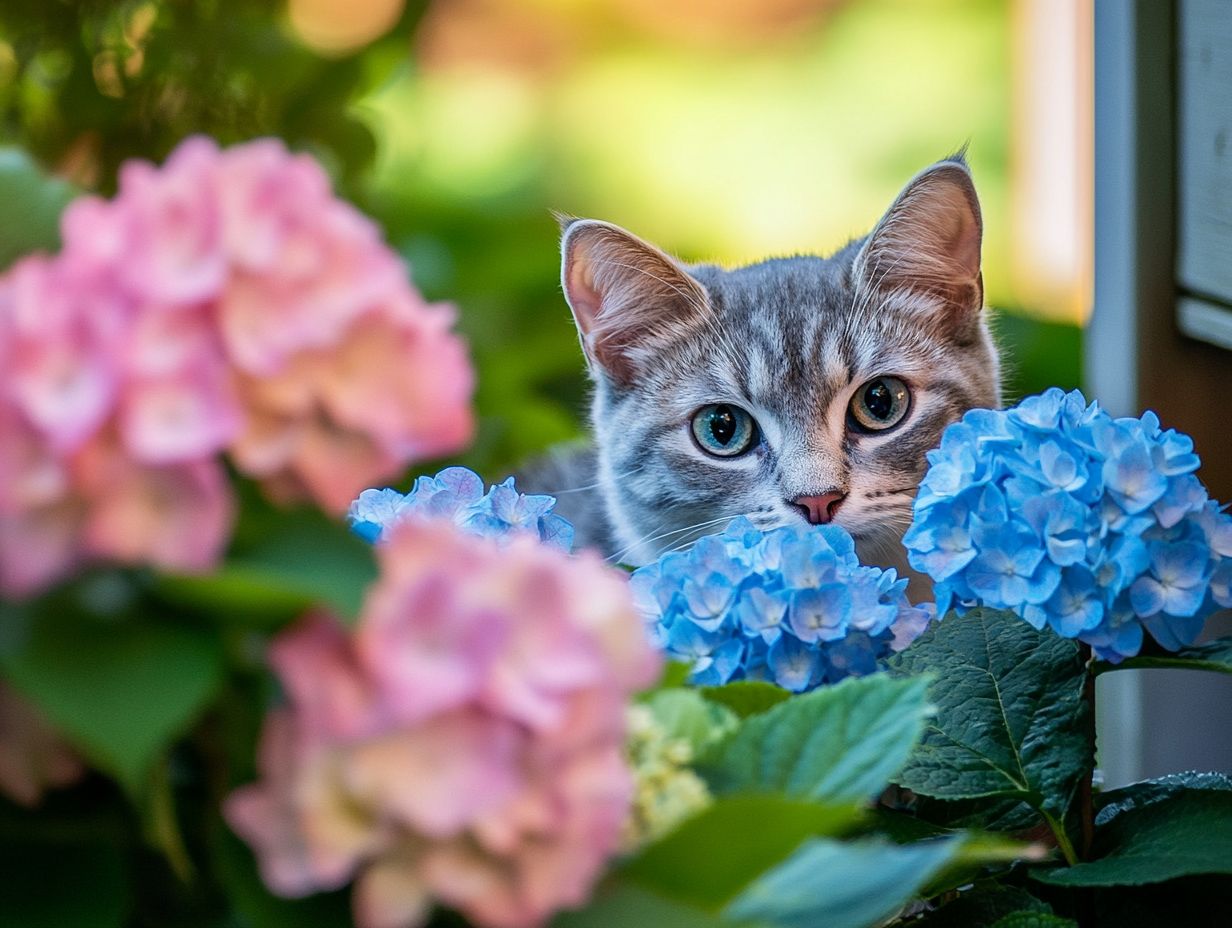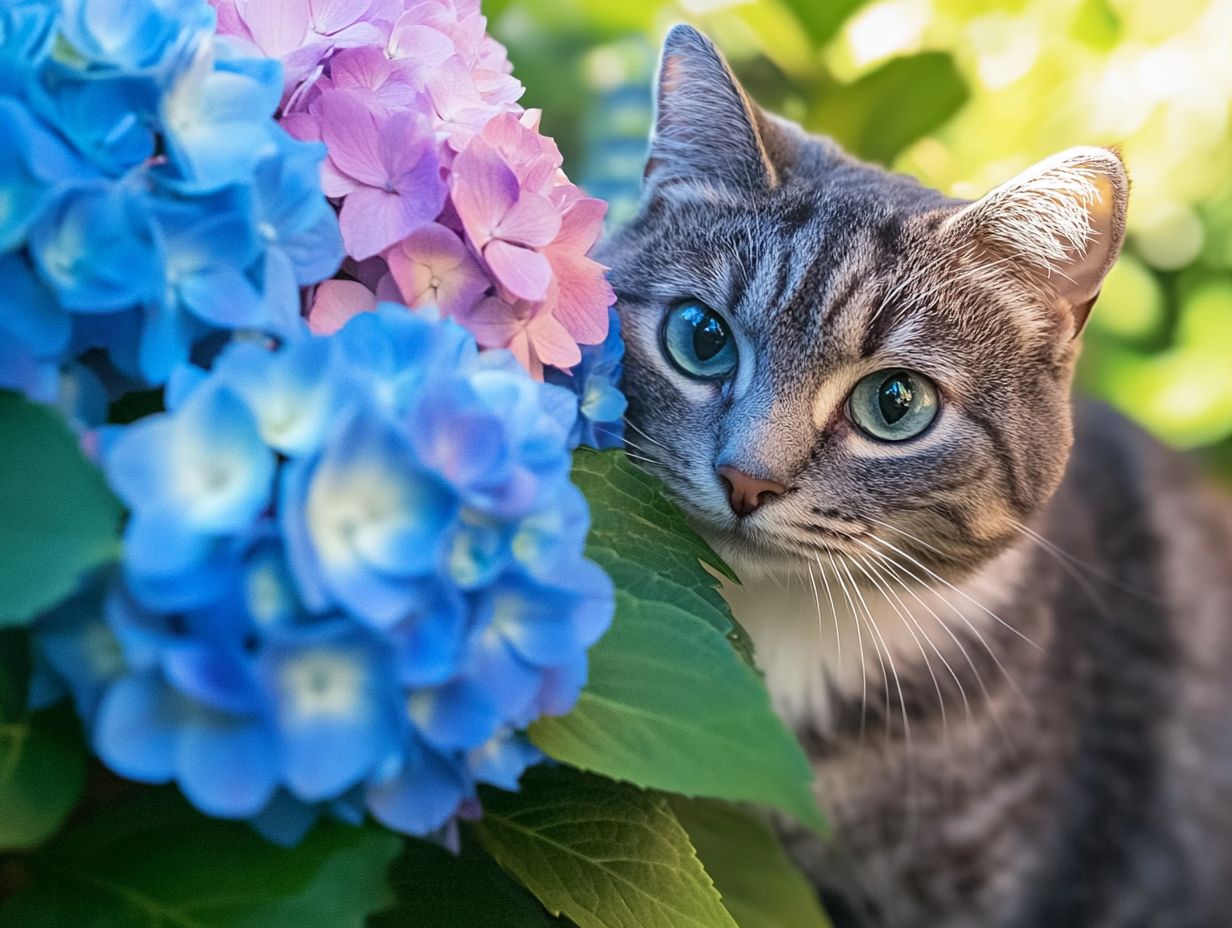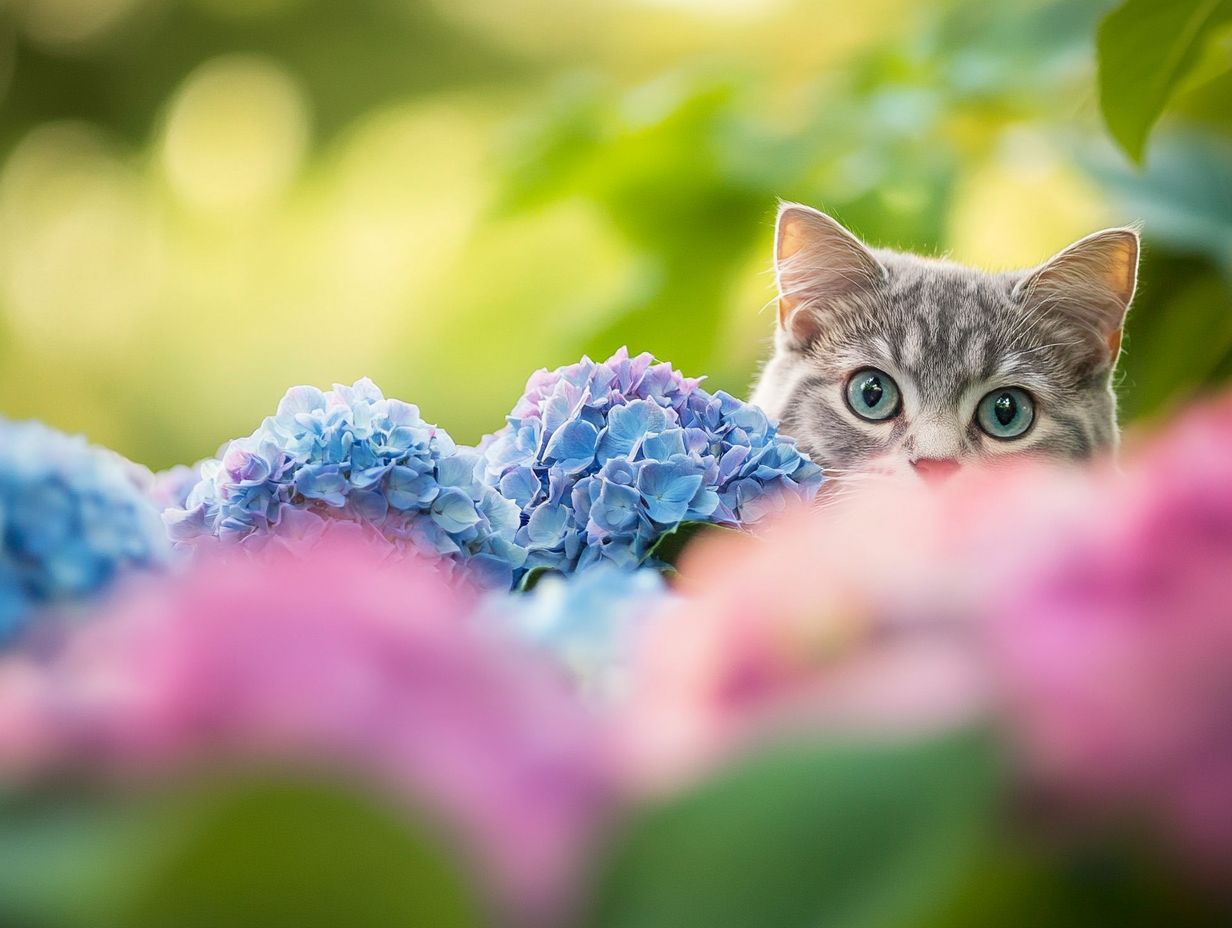Hydrangeas (Hydrangea macrophylla) are beloved for their vibrant blooms, but if you’re a cat owner, you might wonder about their safety for furry friends, including dogs. Toxicity Level: Toxic to Cats
This article examines whether hydrangeas are toxic to cats and dogs and the specific parts of the plant that pose risks due to cyanogenic glycosides. Source: ASPCA
It discusses the symptoms of hydrangea poisoning, including gastrointestinal disturbances, how it’s diagnosed and treated, and ways to prevent any unfortunate encounters, incorporating advice from veterinary experts. Additionally, there are recommendations for safe alternatives to keep your home beautiful without jeopardizing your cat’s health.
Key Takeaways:

- Hydrangeas contain toxic substances, namely cyanogenic glycosides, that can harm cats and dogs if ingested.
- Symptoms of hydrangea poisoning in cats include vomiting, diarrhea, and difficulty breathing.
- Cats can recover from hydrangea poisoning with prompt treatment and prevention measures, such as keeping plants out of reach.
What Are Hydrangeas? Understanding Their Varieties and Risks
Hydrangeas are vibrant flowering plants that belong to the genus Hydrangea. These flowering shrubs are commonly found in many backyards and gardens. They are renowned for their large, colorful blooms, which can be blue, pink, purple, or white, depending on soil pH and other environmental factors. However, it’s important to note that they contain cyanide, a critical toxin for pets.
As one of the most popular types of flowering plants, hydrangeas are a favorite choice for gardens. Despite their beauty, hydrangeas pose health risks and should be planted with caution around pets.
Are Hydrangeas Toxic to Cats? Essential Information for Pet Owners
Hydrangeas are toxic to cats due to the presence of cyanogenic glycosides, which can cause serious health issues if ingested. Dr. Aziza Glass from CAWLM Veterinary Hospital emphasizes that although these ornamental plants enhance outdoor spaces, pet owners should exercise caution, as consuming any part of the hydrangea plant can lead to gastrointestinal disturbances, cyanide poisoning, and other severe symptoms in cats and dogs.
What Parts of the Hydrangea Plant are Toxic to Cats?
Yes, hydrangeas are toxic to cats. All parts of the hydrangea plant, including flowers, leaves, and stems, are toxic to cats. While the level of toxicity may vary, pet owners should assume that even small amounts can trigger harmful reactions in their curious feline companions.
Hydrangeas contain toxic compounds known as cyanogenic glycosides, which can disrupt cellular processes and result in various symptoms in cats and other pets. The beautiful blooms, which can be shades of blue or pink, are problematic if ingested, and the leaves and woody stems are also dangerous.
Symptoms of hydrangea poisoning may include:
- Mild Symptoms: Vomiting, diarrhea.
- Moderate Symptoms: Lethargy, abdominal pain, increased salivation, and loss of appetite.
- Severe Symptoms: Tremors, ataxia, and coma.
Gardeners and pet owners with indoor plants should take precautions to keep their pets away from hydrangeas. For more information, check out Are Hydrangeas Toxic to Cats? Understanding the Health Risks, and consult the ASPCA Poison Control or Pet Poison Helpline in emergencies.
What Happens if a Cat Eats Hydrangeas?

If a cat consumes hydrangeas, it may exhibit symptoms such as vomiting, diarrhea, and lethargy due to the plant’s toxicity. Pet owners should be vigilant about recognizing these symptoms quickly, as timely veterinary treatment can prevent serious complications from arising. Additionally, a cat may show signs of toxicity such as abdominal pain, increased salivation, or loss of appetite, which should be taken seriously. In moments of distress for both the pet and its owner, it is essential to remain calm and act swiftly.
First Aid for Suspected Poisoning
If you suspect your cat has ingested hydrangeas:
- Immediately contact a veterinarian.
- Do not induce vomiting unless instructed to do so by a professional.
- Provide as much information as possible, including the amount ingested and the time of ingestion.
Prevention and Safety Measures
To keep hydrangeas out of reach:
- Plant hydrangeas in areas inaccessible to pets.
- Consider using non-toxic alternatives like marigolds, petunias, or sunflowers to maintain home aesthetics.
Common Misconceptions
Some people believe that only certain varieties of hydrangeas are toxic; however, all varieties contain cyanogenic glycosides that can be harmful to cats.
Balanced Perspective
While hydrangeas add beauty to gardens, pet owners must consider the risks. Minor issues can arise even with non-toxic plants, such as mild gastrointestinal upset. Always consult with a veterinarian when unsure.
Special Considerations
Kittens, senior cats, and cats with pre-existing health conditions may be at greater risk, so it’s essential to maintain heightened awareness for these demographics.
Expert Input
“Always consult with a veterinarian if you suspect poisoning,” advises Dr. Aziza Glass. “Timeliness is critical.”
Emergency Contacts
For immediate assistance, contact:
- ASPCA Animal Poison Control: 1-888-426-4435
Disclaimer: This information is not a substitute for professional veterinary advice. Consult a veterinarian for specific concerns.
Last reviewed on [insert date]. For the latest information, please consult reputable sources.
For more details on other plants toxic to cats, check our related articles on pet safety.
- First, assess how much of the plant was ingested and observe any changes in the cat’s behavior, including symptoms like vomiting and diarrhea. It is also advisable to keep a sample of the plant for identification purposes.
- Next, contact a pet poison helpline or veterinarian, who can guide you on the appropriate steps to take.
- Acting quickly allows for treatment to be administered before the situation escalates.
What Are the Symptoms of Hydrangea Poisoning in Cats?
Hydrangeas are considered toxic to cats, particularly their leaves and flowers. Symptoms of hydrangea poisoning in cats can vary and may include:
- Mild Symptoms: Gastrointestinal upset such as vomiting and diarrhea.
- Moderate Symptoms: Lethargy, decreased appetite, and abdominal discomfort.
- Severe Symptoms: Difficulty breathing, seizures, or severe gastrointestinal distress.
Other serious signs may also present, necessitating immediate veterinary intervention.
Are All Cats Affected by Hydrangea Poisoning?
Not all cats will respond the same way to hydrangea poisoning, as individual sensitivities can vary significantly based on factors such as size, age, and overall health. Dr. Tony Coronado from Thrive Pet Healthcare notes that some cats may experience severe reactions to hydrangea ingestion, while others may exhibit minimal symptoms or none at all. Therefore, it is essential to monitor all pets closely.
The variability in response can also be influenced by breed, as certain breeds may have genetic traits that render them more resistant or more sensitive to toxins. Additionally, nutritional status plays a crucial role; a well-nourished cat is likely to cope better with the effects of poisoning than a malnourished one.
Existing health conditions also significantly impact how a cat reacts to hydrangea poisoning, highlighting the importance of veterinarians like those from the University of Illinois College of Veterinary Medicine in providing accurate assessments and tailored care plans for pet owners.
How is Hydrangea Poisoning Diagnosed in Cats?
The diagnosis of hydrangea poisoning in cats is carried out through a veterinary examination. During this process, the veterinarian will inquire about the cat’s symptoms, medical history, and possible exposure to the plant. Effective communication regarding the cat’s environment and potential exposure is essential for achieving an accurate diagnosis and treatment.
Veterinarians look for specific symptoms, such as vomiting, diarrhea, and lethargy. They may also recommend laboratory tests, including blood tests and urinalysis, to confirm their findings and evaluate the overall condition of the cat, assessing whether harmful compounds are present. Additionally, they will check the environment for any hydrangea plants or other potential toxins.
If you suspect that your cat has encountered a toxic situation, it is crucial to seek veterinary assistance immediately. Prompt treatment can significantly improve the prognosis and reduce the risk of severe complications. For more information, check out Are Hydrangeas Toxic to Cats? Understanding the Health Risks.
What is the Treatment for Hydrangea Poisoning in Cats?

The treatment for hydrangea poisoning in cats typically takes place in an emergency veterinary care setting like CAWLM Veterinary Hospital and involves methods such as decontamination and hydration to manage symptoms and support recovery.
The specific treatment plan will vary depending on the severity of the symptoms and the amount of plant material ingested.
Can Cats Recover from Hydrangea Poisoning?
Yes, many cats can recover from hydrangea poisoning with prompt and appropriate veterinary care, particularly if the amount ingested is small and treatment begins early.
The prognosis largely depends on the cat’s overall health, the quantity of hydrangea consumed, and the severity of the poisoning. Additionally, the effectiveness of the treatment administered plays a significant role in the recovery outlook.
Close monitoring of the cat allows for real-time assessment of its response to treatment. In some severe cases, there may be long-term consequences, such as gastrointestinal complications or liver damage, which could necessitate further medical management.
How Can Hydrangea Poisoning in Cats Be Prevented?
To prevent hydrangea poisoning, pet owners should:
- Identify and remove any hydrangea plants in their home or garden.
- Educate themselves on common household plants that are toxic to cats.
- Monitor their pets during outdoor activities to avoid accidental ingestion.
Emergency Contact: For immediate assistance, contact the ASPCA Animal Poison Control at (888) 426-4435.
Disclaimer: This content is not a substitute for professional veterinary advice. Always consult a veterinarian for health-related questions.
Last Reviewed: [Insert date here] — It is important to regularly review and update this information as new research emerges.
Preventing hydrangea poisoning in cats is achievable by creating a pet-friendly garden and ensuring that toxic plants are kept away from curious pets.
Supervision and educating pet owners about the dangers of hydrangeas can effectively help keep inquisitive cats safe.
What Are Some Safe Alternatives to Hydrangeas for Cat and Dog Owners?
Cat and dog owners looking for pet-safe alternatives to hydrangeas can discover a variety of plants and flowers that are safe to have around cats and dogs and are entirely non-toxic. Marigolds, sunflowers, and catnip are just a few examples of pet-friendly plants that pose no risk of poisoning. Ferns, spider plants, and bamboo are excellent choices that can be grown safely both indoors and outdoors, providing a comfortable atmosphere for both owners and their pets.
Spider plants offer air-purifying benefits, thrive with minimal sunlight, and are well-suited for indoor environments. Boston ferns, on the other hand, prefer to be kept outdoors, flourishing in humid conditions and enjoying indirect light. Bamboo requires very little maintenance and can adapt to a variety of settings, contributing to a pet-friendly garden.
A helpful design tip for creating gardens with these plants is to group them in large clusters, which can create a dense and colorful environment. Incorporating shaded areas and cozy nooks will encourage pets to explore and relax, resulting in a vibrant space that is both beautiful and safe for pets.
Frequently Asked Questions About Hydrangeas and Pet Safety

Are Hydrangeas Toxic to Cats and Dogs?
Toxic: Yes, hydrangeas can be toxic to pets, especially cats if ingested. These beautiful plants contain cyanogenic glycosides, which can lead to gastrointestinal disturbances such as vomiting, diarrhea, and lethargy in curious cats.
What parts of the hydrangea plant are toxic to cats?
- Flowers
- Leaves
- Stems
How much hydrangea does a cat need to ingest for it to experience poisoning?
The amount of hydrangea that can be toxic to a cat varies depending on the size of the cat and the concentration of cyanogenic glycosides in the plant. To ensure safety, it’s critical to keep all hydrangea plants out of reach of pets to prevent any potential poisoning.
What are the symptoms of hydrangea poisoning in cats?
Symptoms can be categorized into:
- Mild: Vomiting, diarrhea
- Moderate: Lethargy, abdominal pain
- Severe: Difficulty breathing, seizures, coma
Immediate veterinary care is advised.
What should I do if my cat has ingested hydrangea?
- Stay calm and assess the situation.
- Contact your veterinarian or a pet poison control hotline immediately.
- If advised, take your cat to the vet for evaluation.
- Do not induce vomiting unless instructed by a professional.
- Provide supportive care as directed by the veterinarian.
Can I have hydrangeas in my home if I have cats?
To prevent any potential risks, it’s best to avoid having hydrangeas in your home if you have cats. If you do have these colorful blooms, make sure they are placed in an area that is inaccessible to your cats. Consult with pet health experts like Dr. Aziza Glass from Thrive Pet Healthcare for more advice on creating a pet-friendly environment.
Prevention and Safety Measures
To keep your pets safe:
- Regularly check your garden for hydrangeas and remove them if necessary.
- Educate family members about the dangers of toxic plants.
- Consider using barriers to keep pets away from potentially toxic areas.
Common Misconceptions
Many believe that only certain types of hydrangeas are toxic. However, all parts of the hydrangea plant can pose a risk to pets if ingested.
Emergency Contact
For immediate assistance, contact the ASPCA Animal Poison Control at (888) 426-4435.
This content is for informational purposes only and should not replace professional veterinary advice. Last updated: [Insert Date].